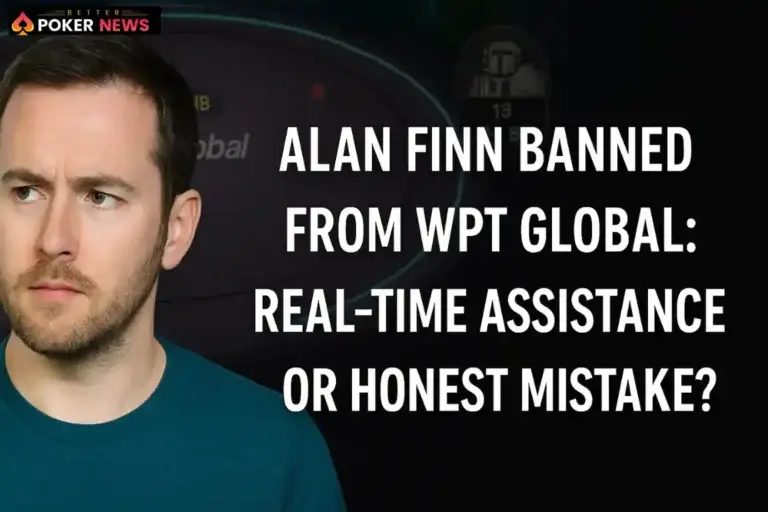In the high-stakes world of online poker, trust is everything. Players stream their sessions live, fans tune in from around the world, and platforms go to great lengths to ensure fair play. But on a seemingly normal day in May 2025, that trust was shaken. Alan Finn—a well-known Irish poker streamer who goes by the handle “AlanFPoker”—was banned from WPT Global after viewers spotted something strange during one of his live Twitch streams. What followed was a storm of controversy, debates across the community, and a harsh reminder that even perceived shortcuts in poker come with serious consequences.
A Spreadsheet Named “WPT Range”: Where It All Began
The drama unfolded when respected poker pro Patrick Leonard noticed something odd during Finn’s Twitch stream. In a screenshot that quickly went viral on X (formerly Twitter), two Excel files could be seen open on Finn’s screen: one titled “Mom’s Shopping List,” and the other—more concerning—titled “WPT Range.”
While the first was likely harmless, the second raised red flags. “WPT Range” appeared to contain detailed preflop hand charts—essentially a digital guide to what hands to play in which positions. In the poker world, this sort of tool is commonly known as Real-Time Assistance (RTA). And while RTAs vary in complexity, even simple charts can cross the line if used during live play.
That single frame set off a chain reaction, bringing WPT Global’s rules—and Alan Finn’s streaming habits—under intense scrutiny.
WPT Global Drops the Banhammer
It didn’t take long for WPT Global to respond. Citing a breach of their strict anti-cheating policy, the platform announced via their official social media channels that Alan Finn had been banned. The decision, they said, was based on a violation of Rule 9.2: a regulation that prohibits any form of External Player Assistance (EPA) that could distort play or give an unfair edge.
This rule, like many others in the online poker community, is designed to preserve the integrity of the game. Players must make decisions in real-time, using their own judgment—not based on externally provided information, even if it’s something as simple as a spreadsheet.
WPT Global’s stance was clear: regardless of intent or the simplicity of the tool, a rule was broken.
Poker in the Age of Technology: Where’s the Line?
The reaction from the poker community was immediate—and divided. Some applauded WPT Global’s swift and decisive move, praising the platform for standing up against any form of cheating, however minor it might seem.
Others questioned whether the punishment fit the crime.
“It wasn’t a bot,” some argued. “It wasn’t real-time solver advice or an AI tool giving decisions. It was a basic range chart—something many players have studied offline.”
And that’s where the gray area lies. In modern online poker, particularly at the higher stakes and among professionals, players spend hours studying ranges, simulations, and advanced strategies. Many memorize them. But once play starts, using even pre-studied charts during the game can blur into EPA territory—especially if it offers real-time guidance.
What Exactly Is Real-Time Assistance (RTA)?
To understand why this matters, let’s break it down. RTA in poker refers to any tool or software that helps players make decisions during an active hand. This can range from solvers running in the background to static charts offering preflop suggestions.
While platforms differ slightly in their definitions, most agree on one thing: if the tool is used while the hand is ongoing, it qualifies as real-time assistance—even if it’s not dynamic or AI-driven.
In Finn’s case, the WPT Range sheet was visible during play. That’s what sealed the deal.
Alan Finn’s Silence and the Future of Streamed Poker
As of now, Alan Finn hasn’t issued a public statement defending or apologizing for the incident. His Twitch account has gone quiet, and speculation continues to swirl.
This silence has left his fans wondering: Was it a genuine mistake? Was the chart open by accident? Or was he knowingly crossing a line?
Regardless of the answer, this incident serves as a wake-up call—not just for streamers, but for all poker players navigating the fine line between study and cheating.
The Slippery Slope of Spreadsheets and Study Aids
What makes this story so compelling is that it hits close to home for many grinders. Plenty of players use spreadsheets, offline GTO charts, and color-coded hand maps to refine their skills. That’s part of getting better. But the rules are clear: once you’re in a game, it’s you versus your opponents—no aids, no guides, and no shortcuts.
Even something as innocuous as an open Excel file can result in a permanent ban. That’s the risk, and that’s the reality of modern online poker.
Rebuilding Trust in the Poker Community
Incidents like these can damage a player’s reputation irreparably, and they also raise difficult questions for streaming platforms and poker sites. Should Twitch enforce tighter rules for poker streamers? Should platforms allow players to explain themselves before being banned?
While the answers may vary, the need for transparent policies, education on what counts as RTA, and consistent enforcement has never been greater. WPT Global, for its part, made a strong statement about where they stand. And for now, that stance is clear: if there’s any doubt, they’ll err on the side of integrity.
Final Thoughts
The Alan Finn ban is more than just a single player facing consequences—it’s a moment of reckoning for the entire online poker community. As games grow tougher, stakes climb higher, and technology becomes more accessible, the pressure to find an edge will only increase.
But in the race to win, integrity can’t be sacrificed. Poker has always been a game of skill, nerve, and fairness. WPT Global reminded the world of that this week, and players everywhere—streamers included—will need to adapt, adjust, and above all, play fair.
BetterPokerNews remains committed to reporting the most important stories shaping poker worldwide. From WSOP updates to online scandals, we deliver honest, insightful, and in-depth reporting that puts players first.
Source:
Adapted and summarized from PokerNews

